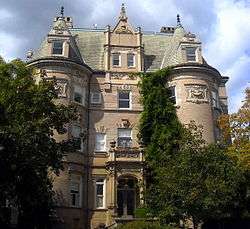Miller House (Washington, D.C.)
| Miller House | |
|---|---|
 | |
| Alternative names | Argyle House |
| General information | |
| Architectural style | Chateauesque |
| Location | Sheridan-Kalorama |
| Address | 2201 Massachusetts Avenue N.W. |
| Town or city | Washington, D.C. |
| Coordinates | 38°54′42″N 77°02′56″W / 38.911528°N 77.048835°W |
| Completed | 1901 |
| Design and construction | |
| Architect | Paul J. Pelz |
Miller House is a mansion on the Embassy Row section of Massachusetts Avenue in Washington, D.C.. It was designed by Paul J. Pelz, the architect of the Library of Congress, in the Northern Renaissance style, and built in 1900-01 for Commander Frederick Augustus Miller (1842–1909). Because Miller had been a U.S. Navy officer during the U.S. Civil War the house includes a number of maritime motifs, including the statue of a ship's cat on the ledge facing Massachusetts Avenue.
The house was sold by Miller's widow in 1913 and changed hands several times afterwards. During most of the 1920s it was owned by Washington developer Harry Wardman or his business partners. In 1923-26 it was leased to the Costa Rican and Salvadorean Legations. Like many mansions in Northwest Washington, D.C., it was then divided into apartments during the Great Depression and rented as a boarding house. In the early 1960s it was owned by Oscar Sydney Cox, who in 1940-41 had been instrumental in drafting and administering the Lend-Lease Act.[1]
In 1984 the building was renovated by its then-owner, Scott McLeod. The renovation was completed in 1986, in spite of a fire which destroyed many of the house's internal features.[2] It was conducted by Richard Ridley, a local architect and author of the Washington Post's Making Space column from 1982 to 1988, and won a Dupont Circle Conservancy Historic Preservation Award.[3]
An integral part of the house is the former garage on 22nd Street, also built in 1900-01 and one of the first such constructions designed specifically to store an automobile (actually, an electric car) rather than a horse carriage. From 1986 to 2009 it was used by Olga Hirschhorn, widow of entrepreneur and philanthropist Joseph Hirshhorn, to host part of her art collection. Hirschhorn named the 500-square-foot structure her "Mouse House", in playful reference to the house's cat statue. In 2009 the contents of the "Mouse House" were displayed at the Bruce Museum of Arts and Science in Greenwich, Connecticut[4] and then at the Patty & Jay Baker Museum of Art in Naples, Florida where they have since been donated to the permanent exhibition.[5]
Gallery
-
Statue of a cat
-

The "Mouse House"
-
Dining room in 1970 (destroyed in the 1980s)
-
Admiral Farragut memorial window in the dining room (destroyed in the 1980s)
References
- ↑ "Miller House (Argyle Terrace)". Historic Structures. Retrieved 2013-05-10.
- ↑ "Up From the Ashes on Embassy Row", Historic Preservation, September–October 1986
- ↑ "D.C. Architect and Writer Richard Ridley Dies at 49", The Washington Post, October 6, 1988
- ↑ "Tight Quarters (Only 500 Square Feet), but Oh, the Views". The New York Times. September 4, 2009.
- ↑ "Hirshhorn 'Mouse House' now at home in Naples", GoNaples.com, February 21, 2013
External links
![]() Media related to Miller House (Washington, D.C.) at Wikimedia Commons
Media related to Miller House (Washington, D.C.) at Wikimedia Commons